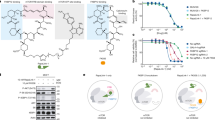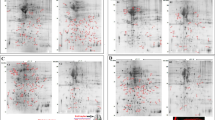Abstract
Aim:
To investigate whether multidrug resistance-associated protein 1 (MRP1) was responsible for drug resistence in refractory epilepsy in amygdale kindling rats.
Methods:
Rat amygdale kindling was used as a model of refractory epilepsy. The expression of MRP1 mRNA and protein in the brains was examined using RT-PCR and Western blot. MRP1-positive cells in the cortex and hippocampus were studied with immunohistochemical staining. The rats were intraperitoneally injected with phenytoin (50 mg/kg) or carbamazepine (20 mg/kg), and their concentrations in the cortical extracellular fluid were measured using microdialysis and HPLC. Probenecid, a MRP1 inhibitor (40 mmol/L, 50 μL) was administered through an inflow tube into the cortex 30 min before injection of the antiepileptic drugs.
Results:
The expression of MRP1 mRNA and protein was significantly up-regulated in the cortex and hippocampus in amygdale kindling rats compared with the control group. Furthermore, the number of MRP1-positive cells in the cortex and hippocampus was also significantly increased in amygdale kindling rats. Microdialysis studies showed that the concentrations of phenytoin and carbamazepine in the cortical extracellular fluid were significantly decreased in amygdale kindling rats. Pre-administration of probenecid could restore the concentrations back to their control levels.
Conclusion:
Up-regulation of MRP1 is responsible for the resistance of brain cells to antiepileptic drugs in the amygdale kindling rats.
Similar content being viewed by others
Log in or create a free account to read this content
Gain free access to this article, as well as selected content from this journal and more on nature.com
or
References
Siddiqui A, Kerb R, Weale ME, Brinkmann U, Smith A, Goldstein DB, et al. Association of multidrug resistance in epilepsy with a polymorphism in the drug-transporter gene ABCB1. N Engl J Med 2003; 348: 1442–8.
Lazarowski A, Czornyj L . Potential role of multidrug resistant proteins in refractory epilepsy and antiepileptic drugs interactions. Drug Metabol Drug Interact 2011; 26: 21–6.
Baguley BC . Multiple drug resistance mechanisms in cancer. Mol Biotechnol 2010; 46: 308–16.
Hipfner DR, Deeley RG, Cole SP . Structural, mechanistic and clinical aspects of MRP1. Biochim Biophys Acta 1999; 1461: 359–76.
Morimoto K, Goddard GV . Seizure-triggering mechanism in the kindling model of epilepsy: I. EEG changes during stimulation from the site of stimulation. Jpn J Psychiatry Neurol 1988; 42: 618–9.
Racine RJ . Modification of seizure activity by electrical stimulation. II. Motor seizure. Electroencephalogr Clin Neurophysiol 1972; 32: 281–94.
Walker MC, Alavijeh MS, Shorvon SD, Patsalos PN . Microdialysis study of the neuropharmacokinetics of phenytoin in rat hippocampus and frontal cortex. Epilepsia 1996; 37: 421–7.
Iram SH, Cole SP . Expression and function of human MRP1 (ABCC1) is dependent on amino acids in cytoplasmic loop 5 and its interface with nucleotide binding domain 2. J Biol Chem 2011; 286: 7202–13.
Borst P, Evers R, Kool M, Wijnholds J . A family of drug transporters: the multidrug resistance-associated proteins. J Natl Cancer Inst 2000; 92: 1295–302.
Perdu J, Germain DP . Identification of novel polymorphisms in the pM5 and MRP1 (ABCC1) genes at locus 16p13.1 and exclusion of both genes as responsible for pseudoxanthoma elasticum. Hum Mutat 2001; 17: 74–5.
Calatozzolo C, Gelati M, Ciusani E, Sciacca FL, Pollo B, Cajola L, et al. Expression of drug resistance proteins P-gp, MRP1, MRP3, MRP5 and GST-pi in human glioma. J Neurooncol 2005; 74: 113–21.
Kubota H, Ishihara H, Langmann T, Schmitz G, Stieger B, Wieser HG, et al. Distribution and functional activity of P-glycoprotein and multidrug resistance-associated proteins in human brain microvascular endothelial cells in hippocampal sclerosis. Epilepsy Res 2006; 68: 213–28.
Lazarowski A, Lubieniecki F, Camarero S, Pomata H, Bartuluchi M, Sevlever G, et al. Multidrug resistance proteins in tuberous sclerosis and refractory epilepsy. Pediatr Neurol 2004; 30: 102–6.
Dombrowski SM, Desai SY, Marroni M, Cucullo L, Goodrich K, Bingaman W, et al. Overexpression of multiple drug resistance genes in endothelial cells from patients with refractory epilepsy. Epilepsia 2001; 42: 1501–6.
Loscher W, Potschka H . Blood-brain barrier active efflux transporters: ATP-binding cassette gene family. NeuroRx 2005; 2: 86–98.
Bronger H, Konig J, Kopplow K, Steiner HH, Ahmadi R, Herold-Mende C, et al. ABCC drug efflux pumps and organic anion uptake transporters in human gliomas and the blood-tumor barrier. Cancer Res 2005; 65: 11419–28.
Sisodiya SM, Lin WR, Harding BN, Squier MV, Thom M . Drug resistance in epilepsy: expression of drug resistance proteins in common causes of refractory epilepsy. Brain 2002; 125: 22–31.
Minich T, Riemer J, Schulz JB, Wielinga P, Wijnholds J, Dringen R . The multidrug resistance protein 1 (Mrp1), but not Mrp5, mediates export of glutathione and glutathione disulfide from brain astrocytes. J Neurochem 2006; 97: 373–84.
Schrenk D, Baus PR, Ermel N, Klein C, Vorderstemann B, Kauffmann HM . Up-regulation of transporters of the MRP family by drugs and toxins. Toxicol Lett 2001; 120: 51–7.
Bao GS, Wang WA, Wang TZ, Huang JK, He H, Liu Z, et al. Overexpression of human MRP1 in neurons causes resistance to antiepileptic drugs in Drosophila seizure mutants. J Neurogenet 2011; 25: 201–6.
Kuteykin-Teplyakov K, Brandt C, Hoffmann K, Loscher W . Complex time-dependent alterations in the brain expression of different drug efflux transporter genes after status epilepticus. Epilepsia 2009; 50: 887–97.
Luna-Tortos C, Fedrowitz M, Loscher W . Evaluation of transport of common antiepileptic drugs by human multidrug resistance-associated proteins (MRP1, 2 and 5) that are overexpressed in pharmacoresistant epilepsy. Neuropharmacology 2010; 58: 1019–32.
Lautier D, Canitrot Y, Deeley RG, Cole SP . Multidrug resistance mediated by the multidrug resistance protein (MRP) gene. Biochem Pharmacol 1996; 52: 967–77.
Nunoya K, Grant CE, Zhang D, Cole SP, Deeley RG . Molecular cloning and pharmacological characterization of rat multidrug resistance protein 1 (mrp1). Drug Metab Dispos 2003; 31: 1016–26.
Salerno M, Garnier-Suillerot A . Kinetics of glutathione and daunorubicin efflux from multidrug resistance protein overexpressing small-cell lung cancer cells. Eur J Pharmacol 2001; 421: 1–9.
Frey HH, Loscher W . Distribution of valproate across the interface between blood and cerebrospinal fluid. Neuropharmacology 1978; 17: 637–42.
Potschka H, Fedrowitz M, Loscher W . Multidrug resistance protein MRP2 contributes to blood-brain barrier function and restricts antiepileptic drug activity. J Pharmacol Exp Ther 2003; 306: 124–31.
Munoz M, Henderson M, Haber M, Norris M . Role of the MRP1/ABCC1 multidrug transporter protein in cancer. IUBMB Life 2007; 59: 752–7.
Acknowledgements
This work was supported by grants from the Natural Science Foundation of Shanghai (09ZR1405500) and the Shanghai Municipal Health Bureau (2008-08) to Yin-hui CHEN and a start-up fund of research from the Jinshan Hospital of Fudan University to Guoxiong XU (2012-2).
Author information
Authors and Affiliations
Corresponding authors
Rights and permissions
About this article
Cite this article
Chen, Yh., Wang, Cc., Xiao, X. et al. Multidrug resistance-associated protein 1 decreases the concentrations of antiepileptic drugs in cortical extracellular fluid in amygdale kindling rats. Acta Pharmacol Sin 34, 473–479 (2013). https://doi.org/10.1038/aps.2012.183
Received:
Accepted:
Published:
Issue date:
DOI: https://doi.org/10.1038/aps.2012.183
Keywords
This article is cited by
-
Inhibition of the NMDA Currents by Probenecid in Amygdaloid Kindling Epilepsy Model
Molecular Neurobiology (2024)
-
Efficiency against multidrug resistance by co-delivery of doxorubicin and curcumin with a legumain-sensitive nanocarrier
Nano Research (2018)
-
Involvement of p38 MAPK in the Drug Resistance of Refractory Epilepsy Through the Regulation Multidrug Resistance-Associated Protein 1
Neurochemical Research (2015)



